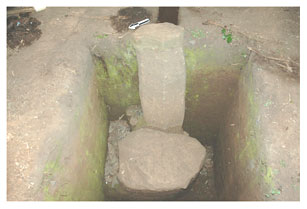| FAMSI © 2007: Barbara Arroyo |
||
The Naranjo Rescue Project: New Data from the Preclassic Guatemala
Research Year: 2006 Table of Contents
Abstract The Proyecto de Rescate Naranjo started as a rescue work required by the Instituto de Antropología e Historia in Guatemala due to the construction of an urban development in the area. An emergency grant was provided by FAMSI to do more fieldwork and support archaeological analysis. Fieldwork began at the end of July 2005 and finished in March 2006. Naranjo is located in the central Guatemalan highlands and has proven to have a Middle Preclassic occupation with a scant Late Classic re-use. The site was completely abandoned by the Late Preclassic, suggesting that it fell under Kaminaljuyú's centralized authority. Its large size, strategic location and large presence of plain monuments, suggest that it may have been one of the earliest ceremonial centers in the region. The settlement pattern study has shown a high population density, suggesting a complex organization of the Middle Preclassic highland society. El Proyecto de Rescate Naranjo se inició como un trabajo de rescate a pedido del Instituto de Antropología e Historia de Guatemala como consecuencia de la construcción de un complejo de desarrollo urbano en la zona. FAMSI gentilmente otorgó una beca de emergencia para continuar realizando más trabajo de campo y análisis arqueológico. El trabajo de campo se inició a fines de julio del 2005 y terminó en marzo del 2006. Naranjo está ubicado en el altiplano central de Guatemala y ha mostrado haber tenido una ocupación principal en el Preclásico Medio, con una escasa reocupación en el Clásico Tardío. El sitio quedó completamente abandonado hacia los inicios del Preclásico Tardío, lo que indicaría que cayó bajo el poder centralizado del vecino sitio de Kaminaljuyú. Sus grandes dimensiones, ubicación estratégica y el elevado número de monumentos sin trabajar en el lugar, sugieren que este sitio pudo haber sido uno de los más antiguos centros ceremoniales de la región. El estudio de patrón de asentamiento muestra una alta densidad de población, lo cual sugiriere una compleja organización de la sociedad del Preclásico Medio en el altiplano. Click to download the report in PDF format: The Naranjo Rescue Project: New Data from the Preclassic Guatemala (3.09 MB)
The PDF files require Adobe Acrobat Reader.
Submitted 08/22/2007 by: |
||
| Return to top of page | ||
|
Text links to all pages at this site are available at the FAMSI INDEX |
||

